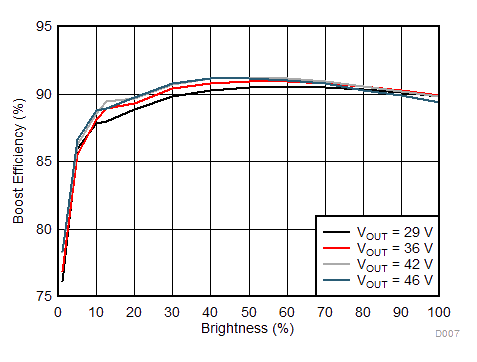JAJSKE4 March 2021 TPS92391
PRODUCTION DATA
- 1 特長
- 2 アプリケーション
- 3 概要
- 4 Revision History
- 5 Pin Configuration and Functions
- 6 Specifications
-
7 Detailed Description
- 7.1 Overview
- 7.2 Functional Block Diagram
- 7.3
Feature Description
- 7.3.1 Control Interface
- 7.3.2 Function Setting
- 7.3.3 Device Supply (VDD)
- 7.3.4 Enable (EN)
- 7.3.5 Charge Pump
- 7.3.6 Boost Controller
- 7.3.7 LED Current Sinks
- 7.3.8 Brightness Control
- 7.3.9
Protection and Fault Detections
- 7.3.9.1 Supply Faults
- 7.3.9.2
Boost Faults
- 7.3.9.2.1 Boost Overvoltage Faults (BSTOVPL, BSTOVPH)
- 7.3.9.2.2 Boost Overcurrent Faults (BSTOCP)
- 7.3.9.2.3 LEDSET Resistor Missing Faults (LEDSET)
- 7.3.9.2.4 MODE Resistor Missing Faults (MODESEL)
- 7.3.9.2.5 FSET Resistor Missing Faults (FSET)
- 7.3.9.2.6 ISET Resistor Out of Range Faults (ISET)
- 7.3.9.2.7 Thermal Shutdown Faults (TSD)
- 7.3.9.3 LED Faults
- 7.3.9.4 Overview of the Fault and Protection Schemes
- 7.4 Device Functional Modes
- 7.5 Programming
- 7.6 Register Maps
-
8 Application and Implementation
- 8.1 Application Information
- 8.2
Typical Applications
- 8.2.1
Full Feature Application for Display Backlight
- 8.2.1.1 Design Requirements
- 8.2.1.2
Detailed Design Procedure
- 8.2.1.2.1 Inductor Selection
- 8.2.1.2.2 Output Capacitor Selection
- 8.2.1.2.3 Input Capacitor Selection
- 8.2.1.2.4 Charge Pump Output Capacitor
- 8.2.1.2.5 Charge Pump Flying Capacitor
- 8.2.1.2.6 Output Diode
- 8.2.1.2.7 Switching FET
- 8.2.1.2.8 Boost Sense Resistor
- 8.2.1.2.9 Power-Line FET
- 8.2.1.2.10 Input Current Sense Resistor
- 8.2.1.2.11 Feedback Resistor Divider
- 8.2.1.2.12 Critical Components for Design
- 8.2.1.3 Application Curves
- 8.2.2 Application With Basic/Minimal Operation
- 8.2.3
SEPIC Mode Application
- 8.2.3.1 Design Requirements
- 8.2.3.2
Detailed Design Procedure
- 8.2.3.2.1 Inductor Selection
- 8.2.3.2.2 Coupling Capacitor Selection
- 8.2.3.2.3 Output Capacitor Selection
- 8.2.3.2.4 Input Capacitor Selection
- 8.2.3.2.5 Charge Pump Output Capacitor
- 8.2.3.2.6 Charge Pump Flying Capacitor
- 8.2.3.2.7 Switching FET
- 8.2.3.2.8 Output Diode
- 8.2.3.2.9 Switching Sense Resistor
- 8.2.3.2.10 Power-Line FET
- 8.2.3.2.11 Input Current Sense Resistor
- 8.2.3.2.12 Feedback Resistor Divider
- 8.2.3.2.13 Critical Components for Design
- 8.2.3.3 Application Curves
- 8.2.1
Full Feature Application for Display Backlight
- 9 Power Supply Recommendations
- 10Layout
- 11Device and Documentation Support
- 12Mechanical, Packaging, and Orderable Information
3 概要
TPS92391 は昇圧コントローラを備えた車載用、高効率の LED ドライバです。6 つの高精度電流シンクは、使用しているチャネル数に応じて自動調整される位相シフトをサポートしています。LED の輝度は、I²C インターフェイスまたは PWM 入力によりグローバルに制御できます。
この昇圧コントローラは、LED 電流シンクのヘッドルーム電圧に基づいた適応型出力電圧制御機能を備えています。この機能により、すべての条件で、必要最低限のレベルに昇圧を調整することで消費電力を最小化できます。周波数を広範囲に調整できるため、TPS92391 は AM ラジオ周波数帯に対する妨害を回避できます。
TPS92391 は組み込みのハイブリッド PWM 調光とアナログ電流調光をサポートしているため、EMI の削減、LED の寿命の延長、総合的な光学効率の向上を実現します。
製品情報
| 部品番号(1) | パッケージ | 本体サイズ (公称) |
|---|---|---|
| TPS92391 | QFN (32) | 5mm × 5mm |
(1) 利用可能なパッケージについては、このデータシートの末尾にある注文情報を参照してください。
 簡略回路図
簡略回路図 システム効率
システム効率